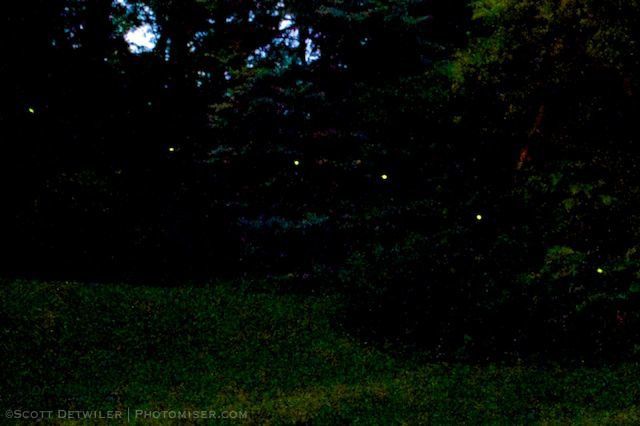I have been experimenting with photographing fireflies the last two nights. I have not gotten quite the look I want, but the posted photograph is one of the better results, such as it is. Here are some things I have learned so far.
1) Use a high ISO. I am finding an ISO of 1600 or 3200 works reasonably well. Anything lower is not fast enough to register the flashes sufficiently.
2) Use a wide open aperture. As with ISO, the light the fireflies put out is faint and brief, you’ve got gather what light you can.
3) With these settings, I was finding that exposures of 8 seconds or longer was the best for picking up not only multiple flashes, but also some of the background detail. This was on a night of a full moon, but the moon was behind the trees. Of course, how well the background develops is going to depend a lot on ambient light. In may case, there were significant outside lighting sources in the area; though distant, they were having some affect on the final outcome. Obviously a tripod or a sturdy surface such as a post or a stump is essential. Exposures longer than 30 seconds started to show lots of those little points of light that digital cameras get on long exposures; they actually look a lot like small firefly flashes, so beware.
4) Focusing in the dark is a bear! Trying to get something in focus from the background was my biggest frustration. Even though the fireflies look like single points of light most of the time regardless, it’s nice to have something else in focus to give a reference. I tried guessing, but was very poor at it. I brought along a strong flashlight to help with manual focus, but that was not as helpful as I had hoped. Another trick was to frame a larger object in the background, like a fence or a tree trunk, and use flashlight, or, if close enough, the auto-focus assist lamp, to focus. The catch to any sort of extra lighting is that it tends to “hush” the fireflies for a few minutes.
Anyway, I think I’m getting the bugs worked out (ha!), and now I just need to be in the right place at the right time to capture a good show. The camera here was a D90 on manual and bulb setting, with a Nikon 18-55mm AF-S DX VR, on this Manfrotto tripod.





